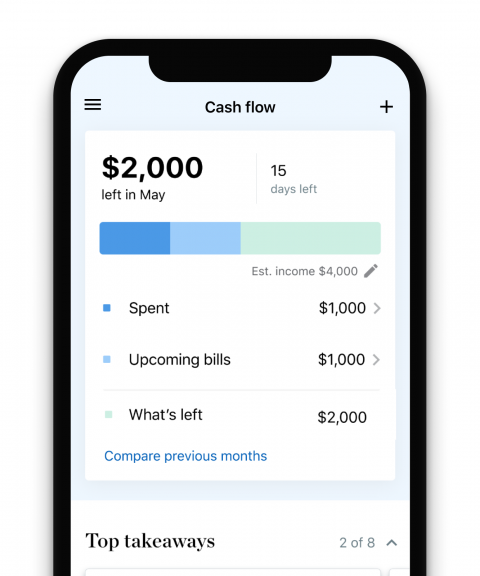Short for “you need a budget,” YNAB is a budgeting app that uses the zero-based budgeting system to help you make a plan for every dollar of your monthly income. The budgeting process is involved, but YNAB’s website offers articles and videos to help users get with the program.
YNAB is a popular app with thousands of reviews and high user ratings (4.8 on the App Store and 4.7 on Google Play). The r/ynab subreddit has 193,000 members. We downloaded and tested the iOS app and used the web-based version of YNAB to find out how it works and who could benefit from it.
What is YNAB?
More than an app, YNAB is a hands-on money management method based on the following four rules:
-
Give every dollar a job. This is zero-based budgeting in a nutshell. You make a plan for how you’re going to use each dollar of your income. An old-school way to do this is to put cash in envelopes marked for specific expenses.
-
Embrace your true expenses. The idea is to take larger, less frequent expenses (like an upcoming vacation) and break them into smaller chunks so you can budget for them each month.
-
Roll with the punches. This rule encourages flexibility; if you’re struggling to pay a bill one month, you can look for other areas to pull back.
-
Age your money. This rule emphasizes watching your spending so you can build savings and increase the time between when you earn money and when you spend it.
It’s hard to argue with the philosophy. These are sound rules that promote better financial habits.
Before you build a budget
NerdWallet breaks down your spending and shows you ways to save.
How much does YNAB cost?
YNAB is a paid budgeting app with no free version, although new users can start with a free trial for 34 days. After that, it costs $14.99 per month or $109 per year. College students get YNAB free for a year.
YNAB may be worth the cost if it helps you spend less and save more money over time.
How does YNAB work?
YNAB is not a set-it-and-forget-it budgeting app. Rather, it encourages you to play an active role in managing your money by defining budgeting categories, allocating money to those categories and then closely monitoring transactions as they occur.
Define expense categories
Initial setup is the most tedious part, but YNAB asks a few questions up front — about debt and what you like to spend money on — to help you define spending categories. Think of these spending categories as line items in a budgeting spreadsheet (like rent, groceries and meals out), but with a fancier design.
It’s important to include every spending category you can think of in your YNAB budget, and you may need to consult bill receipts, credit card transactions and bank statements at first. Don’t forget to add categories for debt payments, saving and investing if applicable.
🤓Nerdy Tip
Do yourself a favor and use YNAB’s desktop site on a laptop to set up your budget. The larger layout makes it easy to be thorough when defining and organizing spending categories.
Complete the setup process by setting spending targets for recurring expenses — like a monthly rent payment that remains relatively constant at $1,500 per month — and add your current bank balance. You can connect your bank or add the balance manually.
Fund expenses (only with money you have)
YNAB wants you to be intentional and honest with yourself about your money, which means only assigning money you have to your budgeting categories. Your bank balance displays at the top of the app and goes down as you allocate funds to each expense category.
YNAB doesn’t restrict you from funding categories with money not yet there (for example, the second paycheck you know is coming later in the month), but you’ll see a negative balance in bright red that shows you’ve assigned more than you have. Here’s how one user put it on a r/YNAB Reddit thread:
“Imagine you have actual cash and you’re trying to put it in envelopes. The red bubble is there because you’re trying to put cash you don’t have yet in the envelopes,” wrote u/HLef in response to a question from a YNAB newbie who was seeing red.
Record and categorize transactions
Funding your expense categories is the planning part of YNAB. Recording transactions is how you monitor actual spending. The hands-on nature of YNAB means you’ll need to record and categorize transactions for a real-time look at how actual spending aligns with how much you’ve allocated to each category. You can manually enter every purchase yourself, or link supported bank and credit card accounts within the app to make importing transactions more automatic.
YNAB is likely to work best when you’re faithful about funding categories and recording transactions in the app.
What are the pros and cons of YNAB?
The big benefit of YNAB — its super hands-on approach that encourages saving — may be a drawback that keeps others away. Also, it costs money.
Pros
-
YNAB is a sound money management philosophy within an app.
-
The app is well-designed and also accessible on desktop.
-
There are lots of resources available to help you learn the YNAB way.
Cons
-
This money management method is really involved, which may make it hard to stick with it.
-
It’s pricey and there is no free version; at $14.99 per month, you’ll spend nearly $900 in five years (or $545 at $109 per year).
What are some YNAB alternatives?
Budgeting apps are all the rage, and there’s no shortage of options to choose from in 2024.
EveryDollar is an app (like YNAB) that makes our best budget apps list and offers a zero-based budgeting framework. Some users may find it simpler to manage than YNAB. EveryDollar has a free and paid version.
PocketGuard is an alternative that’s big on simplifying the budgeting process. Essentially, you can link your bank accounts, credit cards, loans and investments, plus use the app to track net worth and monitor spending. PocketGuard also has a free and paid version.
Who is YNAB for?
YNAB may be for you if you’re serious about optimizing your finances and have the discipline to stick with it. To be effective and get your money’s worth, you’ll need to be in the app adjusting your categories, forecasting where your funds will go and recording transactions on a regular basis. If you can do that, you’ll probably be better with money for it.
Methodology
We chose to review this app because of its popularity and high ratings in both major app stores. We signed up for the free trial and conducted hands-on testing using both the desktop and mobile app versions of YNAB to understand the budgeting process and explore key features.
Before you build a budget
NerdWallet breaks down your spending and shows you ways to save.


